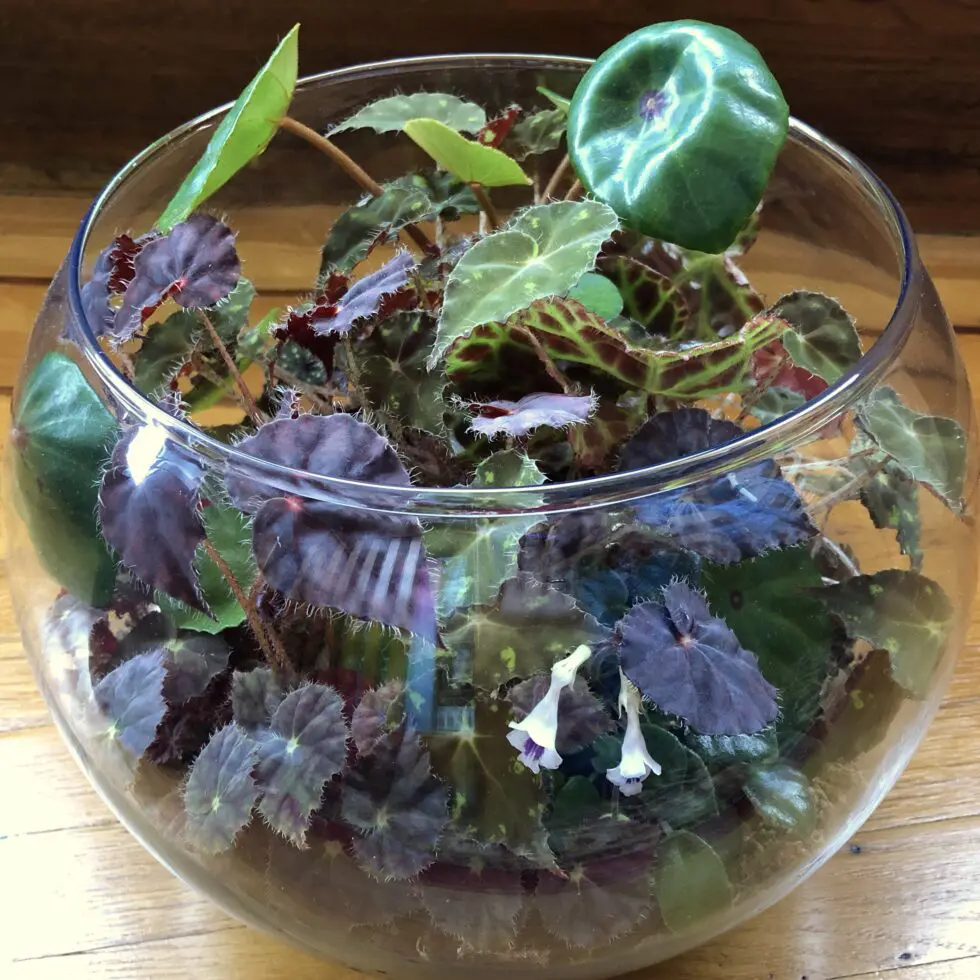Growing begonias in a terrarium is simply growing them in a vessel that creates a balanced environment while providing adequate humidity. Terrariums are used for growing begonias that need this balance in order to grow and thrive. Terrariums are also useful for propagating your begonias. With the addition of moisture, planting medium, and plants, a balanced ecosystem is created and requires little maintenance.
MATERIALS NEEDED TO BUILD A TERRARIUM
Cleanliness is key. All materials and tools should be sanitized in order to avoid introducing bacteria or unwanted organisms.
Selecting your container: Any enclosed vessel will work, bubble bowls, glass jars, aquariums, plastic bins, and containers previously used for food takeout or storage. Even a vase will work with a plastic cover or saran wrap stretch over the opening. Consider the opening, so you can easily remove plants in the future when necessary.
Building the Layers:
- First Layer Foundation: A 1-2” layer of small pebbles should be added to the vessel for drainage purposes. This step mitigates an overwatering issue in extreme cases. A narrow vessel will require a deeper layer of drainage than a wider vessel.
- Second Layer Charcoal: A layer of activated charcoal is added to the bottom of the vessel. One or two layers deep are sufficient. The charcoal will keep the soil medium “sweet”, eliminates odors, and also helps with drainage. A horticultural charcoal or aquarium charcoal is typically used.
- Third Layer Medium: A soilless medium is needed: Pro-mix, sphagnum moss, Miracle Grow Violet Mix, Fox Farm Mix will work. The medium should be moist but not wet.
Tips on Sphagnum: Sphagnum can be hard on roots when plants need repotting. It’s best to cut your long-stemmed moss into smaller pieces and pull out any stems you may have in your packaging. Sphagnum must also be wetted down before using. Best to use distilled water, but boiling the water for a few minutes works fine, or you can let it soak in water for at least 30 minutes. Once wet, squeeze the water out until it no longer drips. It’s a great addition to your terrarium, either as an added ingredient for your soilless medium or used exclusively.
Another tip: Some add a few teaspoons of Neem oil to their water during boiling of sphagnum or add it to soil-medium as an added precaution against pests, pest larvae and it also acts as a fungicide.
Planting your Terrarium:
Considering like-kind needs of the begonias, if you plant more than one. Add your selected plant or plants to the soil, adding more soil as needed to cover the roots and anchoring the plant. Using a long-handled tool such as a fork or spoon affixed to a chopstick for extension works just fine for digging a small hole and tapping down the soil. For aesthetics, you can create hills and valleys to create interesting contours, adding decorative elements such as pebbles, an interesting piece of wood, rocks, shells or other ornamental objects to the world you are creating. Remember to sterilize any additions and consider the size of your vessel. Some terrariums even include frogs and snails! The end result should be a balanced ecosystem with all the requirements needed for your living plants to thrive.
Let It Rain: Spray distilled water into your container and plants. 10 squirts should do, depending on the size of your container. Too much water is to be avoided!
Concentrate on the sides and the leaves of the plant to take off any soil that should be cleared off.
Placement: Keep your terrarium out of direct sunlight.
Cover and Watch! Moisture control will vary with the size of the vessel and the seal of your cover. If your cover is too loose you can seal it with stretched saran wrap and then place your cover. Check for condensation. If you have large drops on the sides of your vessel, open the cover for a few hours until excess moisture evaporates.
Maintenance:
- Open the cover for a few minutes from time to time for fresh air.
- Check the soil for moisture. If it appears dry, spray the surface with a few squirts and check again in a few days for excess condensation. If you fertilize, use a very diluted ¼ strength or less.
- Pull off yellowing leaves and spent flowers. A long-handled tong or tweezer and your digging/tapping tool can help with this operation.


